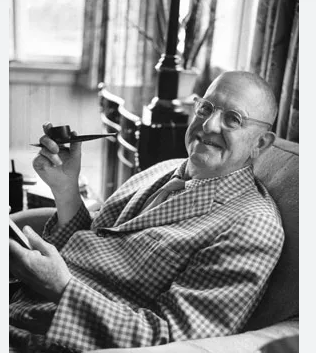By Anne Merino
Special to CSMS Magazine
In this delightful homage to Sir Pelham Grenville Wodehouse, Anne Merino shares her enduring admiration for the master of English comedic fiction. Through an affectionate and insightful exploration of Wodehouse’s life, signature style, and unforgettable characters, she reveals the charm that draws readers, generation after generation, into his whimsical world. Anne’s reflections underscore the timeless appeal of Wodehouse’s humor, elegance, and subtle moral compass, painting a portrait of an author whose works continue to offer an escape into a bygone world of honor, gallantry, and joy.
____________________________________________________________________
Sir Pelham Grenville Wodehouse, KBE, beloved by readers as P.G. Wodehouse and known simply as “Plum” to family and friends, remains one of literature’s most cherished humorists.
P.G. Wodehouse is my favorite writer, a perennial source of cheer whose light, deftly crafted comedic tales of English upper-class social mishaps and whimsical gallantry never fail to lift my spirits.
For those who’ve yet to experience the delightful concoctions of P.G. Wodehouse, here’s a brief introduction. Born in 1881 to upper-middle-class British parents, P.G. attended a traditional English public school, where he was primed for a banking career. Disdainful of business, however, he found his escape just in time, launching himself into journalism and ultimately penning a prodigious array of novels that won immense popularity.
A humorist, Wodehouse mainly set his work in the world in which he grew up – essentially the pre and post WW1 London townhouses and country estates of the upper class. Granted, it’s an idealized universe in which the horrors of WW1 seem never to have occurred, and time has stood still in a kind of an early 20th century English paradise. When I watch the evening news with its bulletins about violence in the Middle East, leaking radiation and various environmental disasters, I often wish I could travel to Wodehouse’s England and never come back.
Why do I love Wodehouse so much? One could argue simplistically – what’s not to love?
He was the best plotter ever – constructing gossamer spiderweb upon spiderweb of dynamic comic mishaps and misunderstandings that are always happily resolved with every delicate thread in place. For example, in one Jeeves and Wooster novel, the acquisition of a silver cow creamer leads to the theft of not one but three policeman hats, at least two broken engagements, the disappearance of a Scottish Terrier, a couple of mysterious personal vendettas and a very disgruntled aunt.
He wrote the best dialogue ever. I always think of a scene in one of the Jeeves stories in which the old school valet is very displeased with a particular suit of a rather bold windowpane check that his employer, Bertie Wooster, has recently acquired. Wooster, wounded by Jeeves’ dim view on modern suiting, proclaims “But, dash it, Jeeves! All the chaps are asking for the name of my tailor!” Jeeves turns away from the cupboard with a slightly raised eyebrow and delivers the ultimate zinger. “No doubt in order to avoid him, sir.”
He produced the pithiest descriptions ever. For example, Wodehouse describes one of the many folly fiancés of Bertie Wooster as “a ghastly dynamic exhibit who read Nietzsche and had a laugh like waves breaking on a stern and rockbound coast.” A lovelorn Mullliner is painted as “A melancholy-looking man, he had the appearance of one who has searched for the leak in life’s gas-pipe with a lighted candle.” He describes one self-satisfied character as looking like “a tiger after his morning ration of coolie.” And another hapless character is described as having “… just about enough intelligence to open his mouth when he wanted to eat, but certainly no more.”
He created the best names ever. Catsmeat Potter-Pirbright. Pongo Twistleton. Veronica Wedge. Percy Frobisher Pilbeam. Sir Gregory Parsloe-Parsloe, Bart.
But I think the thing that draws me the most to Wodehouse is the aforementioned wondrously wacky gallantry. I was brought up in a household that never really understood that the Edwardian era had passed. My parents reared us to adhere to a sort of code of honour that included all sorts of tenets for a civilized society — good sportsmanship, good intentions, thoughtful manners, humility, kindness loyalty, and courage. There was a tacit belief that, in the end, “The Code” would eventually triumph over self-aggrandizement, pomposity, vulgarity and aggression. Apparently, something like a Kardashian event horizon was never even considered a remote possibility.
In P.G. Wodehouse’s world, this Edwardian code of fair play actually wins out in the end. Indeed, Bertie often refers to the Code Of The Woosters as he attempts to come to the aid of friend struggling with a domineering aunt or affairs of the heart — “Never let a pal down”. All of Wodehouse’s wonderfully cantilevered plots draw to a happy close in which the hero finally manages to sort out who has the purloined silver cow creamer and young love is rescued from various incredible misunderstandings. Overbearing businessmen and pushy interlopers are suitably revealed and chastised. Characters who are mean-spirited or pompous and self-aggrandizing always get theirs. I find this very reassuring and comforting in this modern world of hard sell, “selfies” and clueless ambition.
For writers, Wodehouse is an inspiration, his successful career spanning over seventy years and encompassing novels, short stories, plays, essays, and songs for musical theatre. I often daydream of a writing career as lengthy and varied as his.
Quirky details about P.G. Wodehouse only endear him to me more. I love that he shares a name with a type of horse bit called a Pelham (a particular favorite of mine, as it worked wonders with my teenage hunter, Banner). Our birthdays are just a day apart—his on October 15th, mine on the 16th—a sign of mutual genius, I’d like to think. And the fact that he remained devoted to the soap opera “The Edge of Night” into his later years delights me. I can’t help but imagine this KBE, glued to the screen, breathless with suspense over the next plot twist: “But … what about … the baby?”
 Note: Anne Merino is the author of the critically acclaimed novel tiled Hawkesmoor: A Novel of Vampire and Fearie. To learn more about Anne Merino’s work, you can visit her website: Rivercliff Books and Media
Note: Anne Merino is the author of the critically acclaimed novel tiled Hawkesmoor: A Novel of Vampire and Fearie. To learn more about Anne Merino’s work, you can visit her website: Rivercliff Books and Media


